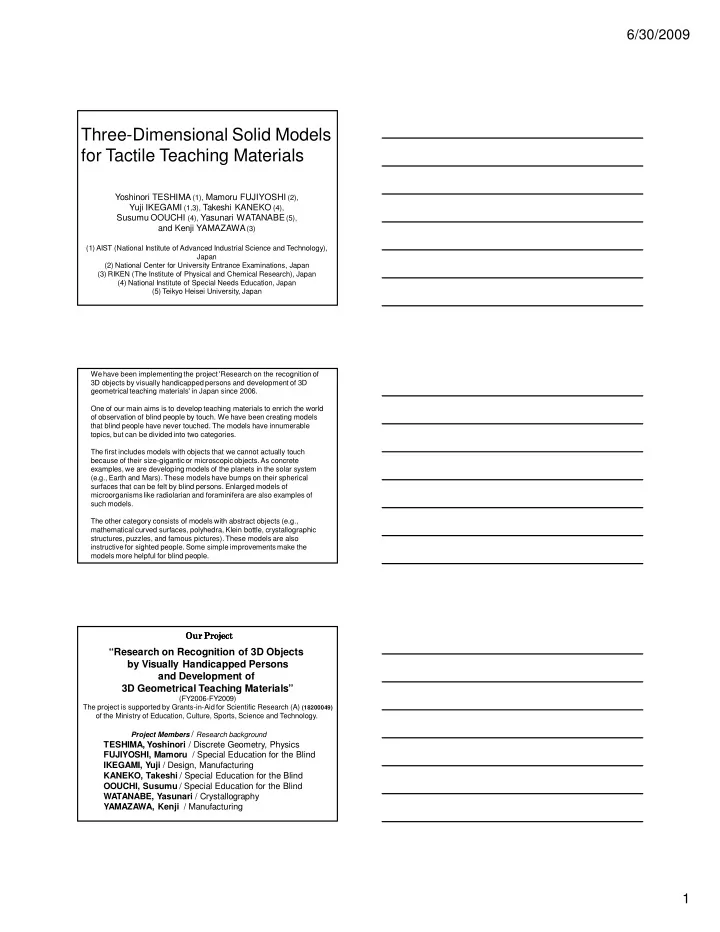

6/30/2009 Three-Dimensional Solid Models for Tactile Teaching Materials Yoshinori TESHIMA (1), Mamoru FUJIYOSHI (2), Yuji IKEGAMI (1,3), Takeshi KANEKO (4), Susumu OOUCHI (4), Yasunari WATANABE (5), and Kenji YAMAZAWA (3) (1) AIST (National Institute of Advanced Industrial Science and Technology), Japan (2) National Center for University Entrance Examinations, Japan (3) RIKEN (The Institute of Physical and Chemical Research), Japan (4) National Institute of Special Needs Education, Japan (5) Teikyo Heisei University, Japan We have been implementing the project 'Research on the recognition of 3D objects by visually handicapped persons and development of 3D geometrical teaching materials' in Japan since 2006. One of our main aims is to develop teaching materials to enrich the world of observation of blind people by touch. We have been creating models that blind people have never touched. The models have innumerable topics, but can be divided into two categories. The first includes models with objects that we cannot actually touch because of their size-gigantic or microscopic objects. As concrete examples, we are developing models of the planets in the solar system (e.g., Earth and Mars). These models have bumps on their spherical surfaces that can be felt by blind persons. Enlarged models of microorganisms like radiolarian and foraminifera are also examples of such models. The other category consists of models with abstract objects (e.g., mathematical curved surfaces, polyhedra, Klein bottle, crystallographic structures, puzzles, and famous pictures). These models are also instructive for sighted people. Some simple improvements make the models more helpful for blind people. ����������� ����������� ����������� ����������� “Research on Recognition of 3D Objects by Visually Handicapped Persons and Development of 3D Geometrical Teaching Materials” (FY2006-FY2009) The project is supported by Grants-in-Aid for Scientific Research (A) (18200049) of the Ministry of Education, Culture, Sports, Science and Technology. Project Members / Research background TESHIMA, Yoshinori / Discrete Geometry, Physics FUJIYOSHI, Mamoru / Special Education for the Blind IKEGAMI, Yuji / Design, Manufacturing KANEKO, Takeshi / Special Education for the Blind OOUCHI, Susumu / Special Education for the Blind WATANABE, Yasunari / Crystallography YAMAZAWA, Kenji / Manufacturing 1
6/30/2009 Tactile Globes: Earth, Mars, Venus, and Moon Yoshinori TESHIMA (1), Tsukasa NAKANO (1), and Akiko TANAKA (1) (1) AIST (National Institute of Advanced Industrial Science and Technology), Japan To enrich the touch world - Miniaturized models Gigantic objects that we cannot recognize in actual size Globes of planets and satellites in the solar system. We created the globes with Exact Topography data from Planetary exploration by the man-made satellite. We gave emphasized ups and downs on their spherical surfaces that can be felt by blind persons. 2
6/30/2009 Globes of Earth -Topography data: ETOP05 Elevation Data created by National Snow and Ice Data Center - Layered Manufacturing 8cm (3D colour printing) with plaster powder 20cm -Real size: 6378 km (radius) -Reduction ratio: 1/63,780,000 (right model) -Relief emphasis ratio : 50 times Globes of Mars Mt. Olympos Three huge volcanoes Valles Marineris -Topography data: Digital Elevation Model Data from NASA - Layered Manufacturing 8cm (3D colour printing) with plaster powder 20cm -Real size: 3397 km (radius) -Reduction ratio: 1/33,970,000 (right model) -Relief emphasis ratio: 25 times Globes of Venus -Topography data: Altimeter and Radiometry Composite Data Record from NASA - Layered Manufacturing 8cm (3D colour printing) with plaster powder 20cm -Real size: 6052 km (radius) -Reduction ratio: 1/60,520,000 (right model) -Relief emphasis ratio : 50 times 3
6/30/2009 Globes of Moon -Topography data: DLTM2_TOPO from NASA - Layered Manufacturing 8cm (3D colour printing) with plaster powder 20cm -Real size: 1738 km (radius) -Reduction ratio: 1/17,380,000 (right model) -Relief emphasis ratio: 12.5 times This work was supported by Grant-in-Aid for Scientific Research (A) (18200049). 4
Recommend
More recommend